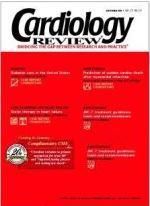Publication
Article
Knowledge of calcium score improves compliance with risk-reducing behavior
NEW ORLEANS—Compliance with lipid-lowering therapy and other cardiac risk factor-modifying behaviors improves when patients know that they have high coronary calcification scores, said Matthew J. Budoff, MD, associate professor of medicine, division of cardiology, Harbor-UCLA Research and Education Institute, Torrance, Calif.
“Electron beam tomography appears to be very useful in addressing our most important issue in preventive medicine today: compliance,” he said. “Coronary artery calcification score may add motivation to asymptomatic patients recommended for lifestyle modifications and drug therapy.”
About 50% of patients who are prescribed lipid-lowering therapy discontinue their drugs within 1 year; this percentage jumps to 75% by year 2. Guidelines for modifying risk in patients with hypertension or dyslipidemia stress a need for long-term compliance among patients at risk for coronary artery disease.
“Successful systems for increasing compliance with exercise, diet, or medical therapy are badly needed,” said Dr. Budoff. He and his colleagues sought to measure whether showing coronary artery calcium results to patients had any effect on behavioral lifestyle changes.
In the study, 1,215 consecutive asymptomatic patients referred for electron beam tomography (EBT) risk assessment by their primary care physicians were sent a survey questioning them about health behaviors. At the time of the original EBT scan, the results were discussed with patients, describing coronary artery calcification as identifying underlying coronary atherosclerosis and being predictive of heart disease risk. Follow-up survey information was obtained from 981 of the patients, a mean of 3.6 years after the baseline scan.
Patients were divided into quartiles based on their coronary artery calcification score: those in the first quartile had a score of 0 to 2, while those in the fourth quartile had scores greater than 285. Patients in the first quartile had the lowest utilization of lifestyle modifications between scans; utilization improved with higher calcium scores, said Dr. Budoff. For example, statin use improved significantly, from 24% among patients with the lowest calcium scores to 74% among those with the highest scores (P < .001). Likewise, dietary modification improved from 34% to 57% (P < .001), and an increase in aerobic activity was reported by 46% of those with the lowest calcium scores compared with 67% of those with the highest scores (P < .001). There was also a trend toward a higher incidence of smoking cessation among patients with higher calcium scores (P = .08).
Persistence with statin therapy was 90% at 3.6 years in patients with coronary artery calcium scores in excess of 400 at baseline, compared with only 44% among those who did not have an EBT scan and 63% who had one but had scores less than 100. A calcium score greater than 100 is a significant risk factor for future cardiovascular events and mortality, noted Dr. Budoff. “Using this cutoff, we found an adherence rate of 83%, and these patients were 5.8-fold more likely to remain on statins than patients with lower scores,” he said.
